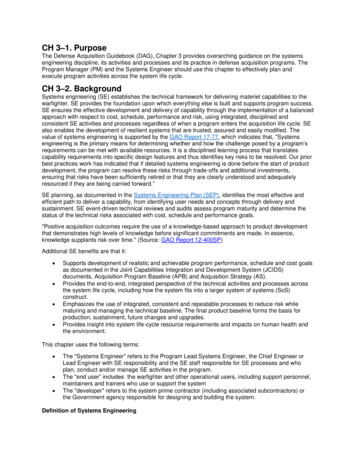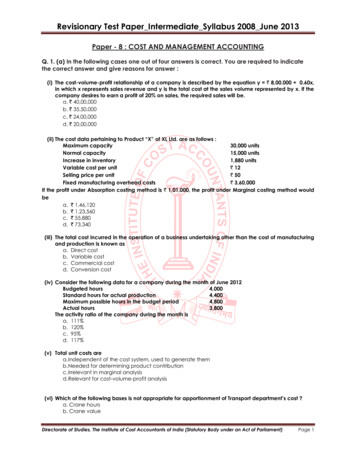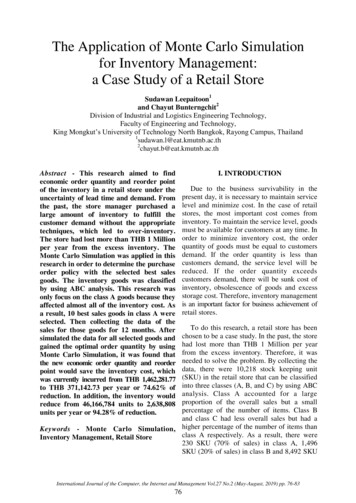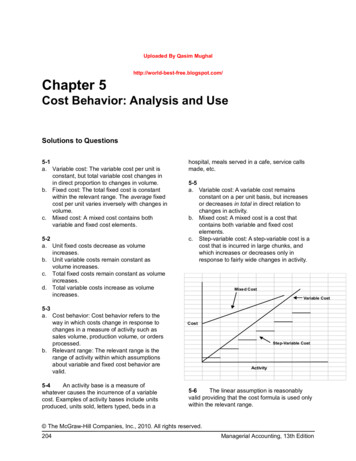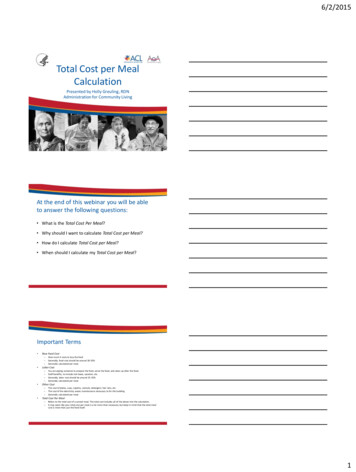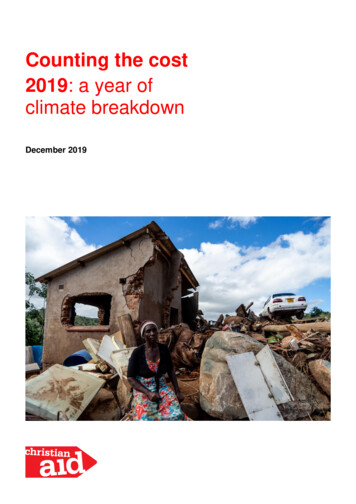
Transcription
Counting the cost2019: a year ofclimate breakdownDecember 2019
2 Counting the cost: 2019: a year of climate breakdownAuthors:Dr Katherine KramerJoe WareChristian Aid is a Christian organisation that insists the world can and mustbe swiftly changed to one where everyone can live a full life, free frompoverty.We work globally for profound change that eradicates the causes of poverty,striving to achieve equality, dignity and freedom for all, regardless of faith ornationality. We are part of a wider movement for social justice.We provide urgent, practical and effective assistance where need is great,tackling the effects of poverty as well as its root causes.christianaid.org.ukContact usChristian Aid35 Lower MarshWaterlooLondonSE1 7RLT: 44 (0) 20 7620 4444E: info@christian-aid.orgW: christianaid.org.ukUK registered charity no. 1105851 Company no. 5171525 Scot charity no. SC039150NI charity no. XR94639 Company no. NI059154 ROI charity no. CHY 6998 Company no. 426928The Christian Aid name and logo are trademarks of Christian Aid Christian Aid December 2019
Counting the cost: 2019: a year of climate breakdown 3ContentsExecutive summary4A year of climate breakdown5Argentina and Uruguay: Floods6Queensland, Australia: Floods7Europe: Storm Eberhard8Southern Africa: Cyclone Idai9Midwest and South US: Floods10Iran: Floods11India and Bangladesh: Cyclone Fani12China: Floods13North India: Floods14China: Typhoon Lekima14Japan: Typhoon Faxai and Typhoon Hagibis15North America: Hurricane Dorian16Spain: Floods17Texas, US: Tropical Storm Imelda18California, US: Fires19Conclusion and recommendations20Cover: Joyce Mwadzura, of Ngangu township inChimanimani, at what was her home before thecyclone, 24 March 2019. The cyclone hit while shewas away at her farm plot, where she was stayingwith her aunt. Her aunt and niece did not survive.After burying her aunt, she got news that her homehad been destroyed. KB Mpofu / Christian Aid
4 Counting the cost: 2019: a year of climate breakdownExecutive summaryExtreme weather, fuelled by climate change, struck every corner ofthe globe in 2019. From Southern Africa to North America and fromAustralia and Asia to Europe, floods, storms and fires brought chaosand destruction.This report identifies 15 of the most destructive weather events ofthe year. All of the disasters caused damage of over US 1 billion,and four of them cost at least 10 billion. These figures are likely tobe underestimates as they often show only insured losses and donot always take into account other financial costs, such as lostproductivity and uninsured losses.By no means do the financial figures show the whole picture – oreven the most important parts of it. The report also providesestimates for the numbers of people killed in each event. Theoverwhelming majority of the deaths were caused by just two events,in India and southern Africa - a reflection of how the world’s poorestpeople pay the heaviest price for the consequences of climatechange. In contrast, the financial cost was greatest in richercountries: Japan and the US suffered three of the four most costlyevents.Each of the disasters in the report has a link with climate change. Insome cases, scientists have identified the physical mechanism bywhich climate change influenced the particular event or calculatedthe extent of its relationship with human-caused warming. In others,the events are consistent with what scientists have warned willhappen as the planet warms.The extremes in this report occurred on a planet that is hotter thananything humans have ever experienced, and it’s going to get worse,due to committed warming from existing emissions. 2019 wasaround 1 C hotter than the pre-industrial average and is likely tohave been the second-hottest year on record. But unless urgentaction is taken to reduce emissions, global temperatures will rise atleast another 0.5 C over the next 20 years, and another 2-3 C bythe end of the century.2019 was not the new normal. The world’s weather will continue tobecome ever-more extreme and people around the world willcontinue to pay the price. The challenge ahead is to minimize theimpacts through deep and rapid emissions cuts.
Counting the cost: 2019: a year of climate breakdown 5A year of climate breakdownDateLocationImpactEstimated cost(US billion)People killedJanuaryArgentina andUruguayFloods2.55January - FebruaryAustraliaFloods1.93MarchEuropeStorm Eberhard1-1.74MarchSouthern AfricaCyclone Idai2.01300March - JuneMidwest andSouth USFloods12.53March - AprilIranFloods8.378MayIndia andBangladeshCyclone Fani8.189June - AugustChinaFloods12300June - OctoberNorth IndiaFloods10.01900AugustChinaTyphoon Lekima10.0101September - OctoberJapanTyphoon Faxaiand HagibisFaxai 5-9Faxai 3Hagibis 15Hagibis 98SeptemberNorth AmericaHurricane s, USTropical StormImelda8.05October - NovemberCalifornia, USFires253
6 Counting the cost: 2019: a year of climate breakdownArgentina and Uruguay: FloodsThe Pampas region of Argentina and Uruguay beganthe year with extremely heavy rain that led towidespread flooding. Rainfall levels set new records,with up to 33cm falling in a single day in parts ofUruguay.1 By mid-January, the region had receivedabout five times the typical amount of rain.2 Thefloods came a year after the same region faced adevastating drought.3The flooding killed five people, cost an estimated 2.5 billion4 andwas Argentina's second-most expensive flood on record.5 Up to 2.4million hectares of soybeans were flooded, according to Coninagro,an agricultural group6 (Argentina is the third largest soybeanproducer in the world7) and more than 11,000 people were forcedfrom their homes.8Argentina’s President, Mauricio Macri, described the floods as “theconsequence of climate change”9 and climate scientists haveidentified the role of human-caused warming in exacerbatingextreme rainfall in the region. Extreme rainfall has increased since196010 and heavy rain and flood risk will continue to grow unlesscarbon emissions fall rapidly.11
Counting the cost: 2019: a year of climate breakdown 7Queensland, Australia: FloodsPhoto: Floodwaters in Albert Street, central Brisbane. Jono Haysom.Queensland, Australia was hit by record-breakingrainfall and floods from January 26 to February 9,from an intense and slow-moving monsoon.12 Morethan two metres of rain fell in parts of the state in 12days13, with some areas receiving their highestrainfall since records began in 1888.14The heavy and prolonged rain killed three people15 and around600,000 cows. 16 It caused significant structural damage, with anestimated cost of 1.9 billion.17 In the city of Townsville, which wasparticularly badly hit, 3,300 homes were damaged by the floods.18Properties in the area risk becoming uninsurable because of climatechange, according to an industry expert.19At the end of the year it was fires, rather than floods, that causeddevastation to parts of Australia and sparked a debate about climatechange in the country. However they didn’t make this list because interms of financial losses they are expected to reach 100m, arelatively small amount compared to other events.Australia has increasingly been experiencing heavy rainfall,20 a trendthat scientists link with climate change, and which is likely to worsenwith further warming.21 The state premier, Annastacia Palaszczuk,
8 Counting the cost: 2019: a year of climate breakdownwarned that the “summer of disasters” hitting Queensland wasevidence of climate change would hurt taxpayers.22 A leadingscientist, Ian Lowe, described the extreme weather that hit the stateover the summer, including the floods, as “unmistakeable signs ofclimate change”.23Europe: Storm EberhardIn mid-March a powerful windstorm (or extratropicalcyclone) moved across Europe, causing widespreaddamage. Storm Eberhard hit the UK, Belgium and theNetherlands from March 9, before moving east toaffect Germany, Poland, the Czech Republic andUkraine. Windspeeds exceeded 140km/h.24The storm caused damage across Europe. At least four people werekilled by falling trees and other debris,25 and insured losses from thestorm have been estimated at 1-1.7 billion.26 Transport was heavilydisrupted, with long delays on railways and roads. Nearly a millionhomes lost electricity across Europe.27Climate scientists have found that severe extratropical cyclones willbe increasingly likely to hit Europe as temperatures rise. Accordingto two separate studies, 28 damaging wind storms will become morefrequent as a result of human-caused warming, and the level ofdamage caused by each storm will increase. Analysis of the impactof these projections for the UK suggested insurance claims fromwindstorms could increase by 50% in parts of the country withcontinued warming.29
Counting the cost: 2019: a year of climate breakdown 9Southern Africa: Cyclone IdaiPhoto: Survivors of flooding receive a food distribution of corn soya blend at KalimaCamp in Chikwawa district, Malawi. Richard Nyoni / Christian AidCyclone Idai made landfall in Mozambique on March14, hitting Mozambique, Madagascar, Malawi andZimbabwe. It brought powerful winds, heavy rain andstorm surges across the region, causing particulardamage in Beira, Mozambique’s second-largest city.Cyclone Idai killed 1,30030 people, making it one of the deadliestSouthern Hemisphere cyclones on record,31 and caused damagesworth over 2 billion.32 Followed by Cyclone Kenneth just a monthlater, the cyclones destroyed buildings, crops, roads and powerinfrastructure, with Mozambique worst affected. The two cyclonesaffected an estimated 2.2 million people33 and Southern Africa'sgrain production fell 7% below its 2018 output.34Scientists have drawn a direct connection between Idai and climatechange, with human greenhouse gas emissions blamed forincreasing the rainfall and coastal flooding that made the storm sodangerous. According to Friedericke Otto of the World WeatherAttribution group, “because of climate change the rainfall intensitiesare higher also because of sea-level rise, the resulting flooding ismore intense than it would be without human-induced climatechange”.35 Warming ocean temperatures also mean cyclones cannow form closer to the poles.36
10 Counting the cost: 2019: a year of climate breakdownChristian Aid’s partner organisations were some of the first torespond to the suffering cause by Idai. Head of Humanitarianprogrammes in Africa, Maurice Onyango, said: “I have seen firsthand the importance of empowering local partners in delivery ofhumanitarian assistance. In Zimbabwe, Christian Aid partners wereamong the first to access and deliver assistance to the communitiesthat were cut off by the floods in Chipinge and Buhera, reachingalmost 1,400 households within the first month.”Midwest and South US: FloodsHeavy rain in the US over an extended period,combined with high temperatures which rapidlymelted the snowpack, led to extensive floodingacross much of the country. The flooding began inMarch in the Midwest, but spread to the South asflood waters flowed down the Missouri, Mississippiand Arkansas rivers. 37 The 12 months prior to June2019 were the wettest in US history.38The widespread flooding caused significant damage across much ofthe country. By June, 11 states had requested disaster funds fromthe federal government.39 Some of the worst-hit states were majorcorn-producing areas and the floods caused major disruption to the2019 harvest.40 At least three people were killed by the floods41 andthe cost of the damage has been estimated at 12.5 billion.42The floods match projections of the consequences of warming andclimate scientists have linked the floods with climate change. Annualprecipitation (rain, snow, sleet and hail) levels have increased in theMidwest because of climate change, leading to more flooding,43 andextreme rainfall is becoming more common worldwide because awarmer atmosphere can hold more water.44 Donald Wuebbels, anatmospheric scientist, said “overall, it’s climate change we expectan increase in total precipitation in the Midwest, especially in winterand spring, with more coming as larger events.”45
Counting the cost: 2019: a year of climate breakdown 11Iran: FloodsPhoto: Aerial shot of flooded homes in Iran. Mohammad Moheimani 46Heavy rain across Iran from mid-March to April led tosignificant flooding and landslides. In one area ofnortheastern Iran, most of a year’s worth of rain fellin just one day.47The floods hit the large majority of the country, with 26 of its 31provinces affected,48 and caused widespread destruction. Across thecountry 78 people were killed, with two million people in need ofhumanitarian assistance, 314 bridges destroyed49 and 179,000houses damaged or destroyed50. One million hectares of farmlandwere also flooded.51 The damage amounted to 8.3 billion,according to the government.52The floods reflect both a trend that scientists have linked with climatechange, and projections of future weather patterns in Iran if warmingcontinues. A 2016 study found that “the hazard and risk of theextreme flood events over Iran are rapidly and exponentiallyincreasing”, along with the frequency of droughts.53 A separatestudy, published in 2019, found that Iran is likely to experience moredays with heavy rain and flooding over the coming decades, as aresult of climate change.54
12 Counting the cost: 2019: a year of climate breakdownIndia and Bangladesh: Cyclone FaniPhoto: This family chose not go to relief shelter (because it was far away) they werehiding between the space on the wall of their destroyed house and their neighbourshouse. Christian Aid / Nirvair Singh.Cyclone Fani was the strongest storm to makelandfall in India in over 20 years, hitting India andBangladesh from May 2-4.55 It had wind speeds up to200 km/h and led to storm surges of 1.5 metre. 56The storm brought heavy rainfall and flooding, causing widespreaddamage that killed at least 89 people, mostly in Odisha.57 More than3.4 million people were displaced,58 more than 10 million trees wereuprooted59 and, in Odisha alone, 140,000 hectares of crop land weredamaged.60 The damage has been estimated at 8.1 billion.61 InNovember, both countries were also hit by Cyclone Matmo (alsoknown as Bulbul), which killed at least 39 people and did damageworth at least 3.4 billion in India alone.62Cyclone Fani reflected the consequences of climate change inseveral ways. Warmer ocean waters increased the energy availableto it, allowing it to build strength; warmer air temperatures allowed itto hold and then drop more water; and sea-level rise increased thestorm surge. According to Prof Michael Mann, a climate scientist,“Fani is just the latest reminder of the heightened threat that millionsof people around the world face from the combination of rising seasand more intense hurricanes and typhoons. That threat will only rise
Counting the cost: 2019: a year of climate breakdown 13if we continue to warm the planet by burning fossil fuels and emittingcarbon into the atmosphere.”63China: FloodsPhoto: Local Chinese residents evacuate by life boat from flooded areas caused byheavy rain in Jiujiang city. Photo: humphery / Shutterstock.From June to August, southern and eastern Chinasaw heavy rain that led to widespread flooding. Partsof the country experienced their highest rainfall innearly 60 years, 51% higher than usual. 64 In Fujianprovince, 15cm of rain fell in just three hours. 65The floods caused major damage across China, killing at least 300people.66 Estimates of the impacts include at least 4.5 million peopleaffected,67 3.7 million hectares of farmland damaged,68 200,000homes and other structures flooded69 and a total economic cost of atleast 12 billion.70The extreme rainfall matches projections of how the climate in Chinacould change as a result of continued warming. As temperaturesrise, a greater proportion of China’s rain is expected to fall inconcentrated downpours, suggesting floods could become a growingrisk.71 This reflects trends seen and projected elsewhere, linked withhuman-caused climate change.72
14 Counting the cost: 2019: a year of climate breakdownNorth India: FloodsExtreme monsoon rain caused widespread floodingin parts of Northern India, as well as Bangladesh andNepal, from June to October. The rainfall was thehighest for 25 years73 and came after a late start tothe monsoon season.74The long-running heavy rain brought widespread flooding anddestruction across parts of India. Government figures suggestednearly 1,900 people were killed in India alone,75 with flooding in 13states and more than three million people forced from their homes.76The damages in India have been estimated at over 10 billion.77 Thefloods also hit Rohingya refugees from Myanmar, in Cox’s Bazar inBangladesh.The floods reflect trends that are being driven by climate change. Ingeneral, climate change makes extreme rainfall more common. Onereason for this is that an atmosphere that is warmer can hold morewater vapour. The world has so far heated about 1 C since preindustrial times78 and, around the world, heavy rainfall hasincreased.79 In North India, rainstorms have become 50% morecommon and 80% longer.80 The trend of more unpredictable andextreme rainfall in India reflects what climate scientists predict willhappen due to climate change, particularly if emissions do not fall.81Another study found that monsoon rainfall will become moreunpredictable, with variability increasing up to 50% this century ifemissions continue to rise.82China: Typhoon LekimaTyphoon Lekima (named Hanna in the Philippines)hit China in August, making landfall in Zhejiang withwinds of 185 km/h.83 It was the fifth-most intensestorm to hit China since 1949.84 Rainfall reached40cm in some areas, leading to widespreadflooding,85 while daily rainfall records fell in 19locations.86The storm caused major damage in China. It triggered floods andlandslides, with transport systems shut down, two million peopleevacuated, 13,000 homes destroyed87 and an estimated 2.7 millionhomes left without power.88 It killed 101 people and is estimated tohave cost at least 10 billion,89 making it the second-most costlytyphoon in Chinese history.90Typhoons that make landfall in Asia have become more destructivein recent decades, with an increase in intensity and more category 4
Counting the cost: 2019: a year of climate breakdown 15or 5 storms.91 These trends are the result of warming oceans thatallows storm systems to pick up more energy. Lekima intensifiedextremely quickly,92 a phenomenon also associated with increasedglobal temperatures. Climate scientists project that the power of thestrongest typhoons will grow even further as global temperaturesincrease.93Japan: Typhoon Faxai and TyphoonHagibisPhoto: Typhoon Faxai bearing down on Japan. Nasa.In September and October, Japan was hit by twounusually strong typhoons, Faxai, followed byHagibis. Faxai was one of the strongest storms to hitTokyo for decades, with winds up to 216km/h.94Hagibis was even stronger, with wind speeds up to225 km/h;95 it dropped close to one metre of rain inplaces within 24 hours.96
16 Counting the cost: 2019: a year of climate breakdownThe storms caused widespread damage. Faxai killed at least threepeople,97 left 900,000 homes without power and disrupted transport.The damage has been estimated at 5-9 billion.98 Typhoon Hagibiswas even more destructive: it is estimated to have cost at least 15billion99 and killed 98 people.100 It also caused widespreaddisruption, including for the Rugby World Cup and Japanese GrandPrix. Other estimates suggest the costs of the storms may havebeen even greater.101Scientists have connected these typhoons and climate change. PiersForster, a leading climate scientist, said “Super Typhoon Hagibisbears the hallmarks of climate change”102, while Xie Shang-Ping,another climate scientist, said: “It's no coincidence that new recordshave recently been set in tropical cyclone intensity. I think we areseeing the climate change effect. The warmer the ocean gets, thestronger tropical cyclones will become."103 Among the featuresconnecting Hagibis with climate change is its rapid intensification: itgained wind speed of 160km/h in a day, which is the fastest rate in23 years104 and reflects a pattern driven by climate change.105Powerful winds in both storms also reflect the global trend of themost intense typhoons becoming stronger,106 a shift that is likely tocontinue with rising temperatures.107North America: Hurricane DorianHurricane Dorian was the second-strongest storm onrecord in the Atlantic,108 making landfall in theBahamas on September 1 as a Category 5 Hurricanewith wind speeds up to 297 km/h and a storm surgeof 5.5 to 7 metres.109 It stalled to almost a standstillover the islands for 40 hours before moving west topass close to the east coast of the US and reachingCanada.The storm had a devastating impact, particularly in the Bahamas. Itkilled at least 673 people across its path, causing damage worth atleast 11.4 billion.110 The damage in the Bahamas has beencalculated at more than a quarter of the country’s GDP. 111 Initialestimates suggested 13,000 homes were destroyed or damaged inthe Bahamas,112 with nearly 70% of homes flooded.113 In the US thedamage was estimated at 1.2 billion.114Scientists have shown how Dorian was driven by climate change.According to leading climate scientists Michael Mann and AndrewDessler, “it’s not a coincidence that Dorian was one of the strongestlandfalling storms ever recorded in the Atlantic”.115 They point to fiveways that climate change made Dorian more dangerous - warmersea waters made it stronger than it would otherwise have been; theyalso allowed it to intensify more quickly; warmer air allowed it tocontain more moisture and so drop more rain; higher sea levels
Counting the cost: 2019: a year of climate breakdown 17pushed the storm surges further inland; and warming may have ledto the storm moving so slowly over the Bahamas.116Spain: FloodsPhoto: Damaged cars in Torrevieja, Spain, due to September floods. Alex Tihonovs.Heavy rain hit southeast Spain in September, withextreme downpours falling in a short period. In someareas of Valencia, 40cm of rain fell in 24 hours, theequivalent of a year’s worth of rain in just one day,while 52cm of rain fell over five days in one location.Six weather stations set new rainfall records.117 Themost affected areas included Valencia, Alicante,Malaga and the Balearic Islands.118The floods killed seven people, with an estimated cost of 2.4billion.119 Floodwaters caused the closure of schools and airportswith states of emergency declared in several regions,120 and over1,100 military personnel deployed.121The extremely heavy rain reflects both trends and projections forparts of Spain. Intense rainfall has increased since the mid-20th
18 Counting the cost: 2019: a year of climate breakdownCentury in parts of southern Spain, according to a 2011 study.122 Aseparate study also projected that short bursts of intense rainfall willbecome more common in the Iberian Peninsula as temperaturesrise.123Texas, US: Tropical Storm ImeldaTropical Storm Imelda, which made landfall in Texasin September, was the fifth-wettest cyclone in UShistory.124 The storm dropped one metre of rain insome areas, with nearly 16cm falling in an hour inone location.125 In Houston, the rainfall set a newrecord.126 It comes only two years after Texas was hitby the country’s wettest-ever storm, HurricaneHarvey,127 meaning parts of the state were hit by twoone-in-500-year rainfall events within 25 months.128The flooding caused by Imelda left cities and roads underwater,damaging homes, businesses and farmland.129 Five people werekilled by the storm,130 and the damage has been estimated at 8billion.131 Imelda also affected airports and seaports, with a knock-oneffect on the area's extensive freight business due to flooding androad closures. 132Climate change made the extreme rainfall in Storm Imelda 2.6 timesmore likely to happen, according to rapid analysis by World WeatherAttribution.133 It also found that climate change increased the rainfallin the storm by 18%. Heavy rainfall is a well-establishedconsequence of climate change, as a warmer atmosphere can holdmore moisture. The trend is clear in Texas, for example four ofHouston’s six wettest days since 1888 have occurred since 2016.134
Counting the cost: 2019: a year of climate breakdown 19California, US: FiresPhoto: The Getty Fire, Los Angeles. Morphius Film.After a quiet start to the fire season in the west of theUS, several major fires broke out in October. Thelargest was the Kincade Fire, which burned over30,000 hectares before it was contained in earlyNovember. It was the largest fire in Sonoma County’shistory.135 Other notable fires around the same timewere the Saddleridge, Tick and Getty Fires.At least three people were killed by the fires136 and the economiccosts have been estimated at over 25 billion,137 meaning they mayhave been the most expensive disasters of 2019. As well as directdamage from the fires, millions of people were left without power asCalifornia’s electricity utility, PG&E, shut down its network to avoidsparking fires. It had been found responsible for starting devastatingfires in previous years due to its failure to maintain towers andwires. 138There is a clear connection between climate change and theincreasing threat of fires in California. According to an academicstudy published in July, the area of California burned each year hasincreased fivefold since 1972 and nearly all of this increase was theconsequence of high temperatures drying out forests and so creatingmore fuel for wildfires.139 Of the 20 largest fires in California’srecorded history, 15 have occurred since 2000.140
20 Counting the cost: 2019: a year of climate breakdownConclusion and recommendationsThis report shows that 2019 was a terrible year forclimate related disasters, but it was also the year thatpeople took to the streets in huge numbers aroundthe globe to demand that politicians started torespond to the science on climate change with theurgency required.The school strikes, started by Swedish teenager Greta Thunberg,swept the globe and culminated with six million people going onstrike in September. Their anger will not be assuaged by the currentlevel of inaction from governments.A report from the Global Carbon Project in December showed thatgreenhouse gasses continue to rise, which will cause climatedisasters to get worse.To minimize future climate impact risks, it’s vital we see globalemissions starting to fall soon and rapidly. 2020 offers the biggesthope for that, as countries meet in Glasgow, Scotland for the biggestclimate summit since the Paris agreement was signed in 2015.In order to make 2020 the year the world turned the corner onclimate change, we need to see countries:-Upgrading their national climate plans (known as NDCs) thatmake up the Paris agreement. Under the terms of theaccord countries are required to strengthen their NDCsevery five years. Currently the pledges of the Parisagreement will deliver a world of more than 3C of globalwarming. We need to see this figure coming down by theend of the Glasgow summit.-Nations need also to commit to a net zero emissions target,the date at which they will stop making the climate crisisworse: globally this needs to be net zero by around 2050. Anumber of countries have already announced these targets,but we need others to follow suit and for them to publishplans of how they will be achieved. All need to implementdeeper action faster, as it is the total amount of emissionsreleased that matters more than the date for achieving netzero.-Rich countries also have a responsibility to mobilise the 100 billion dollars a year they promised to developingcountries to help reduce their emissions and also adapt tothe climate impacts. This was promised back in 2009 and isvital to help poor countries become more resilient and helpthem follow a low-carbon development pathway.
Counting the cost: 2019: a year of climate breakdown 21End /www.abi.org.uk/globalassets/files/publication
change. In contrast, the financial cost was greatest in richer countries: Japan and the US suffered three of the four most costly events. Each of the disasters in the report has a link with climate change. In some cases, scientists have identified the physical mechanism by which climate change influenced the particular event or calculated







